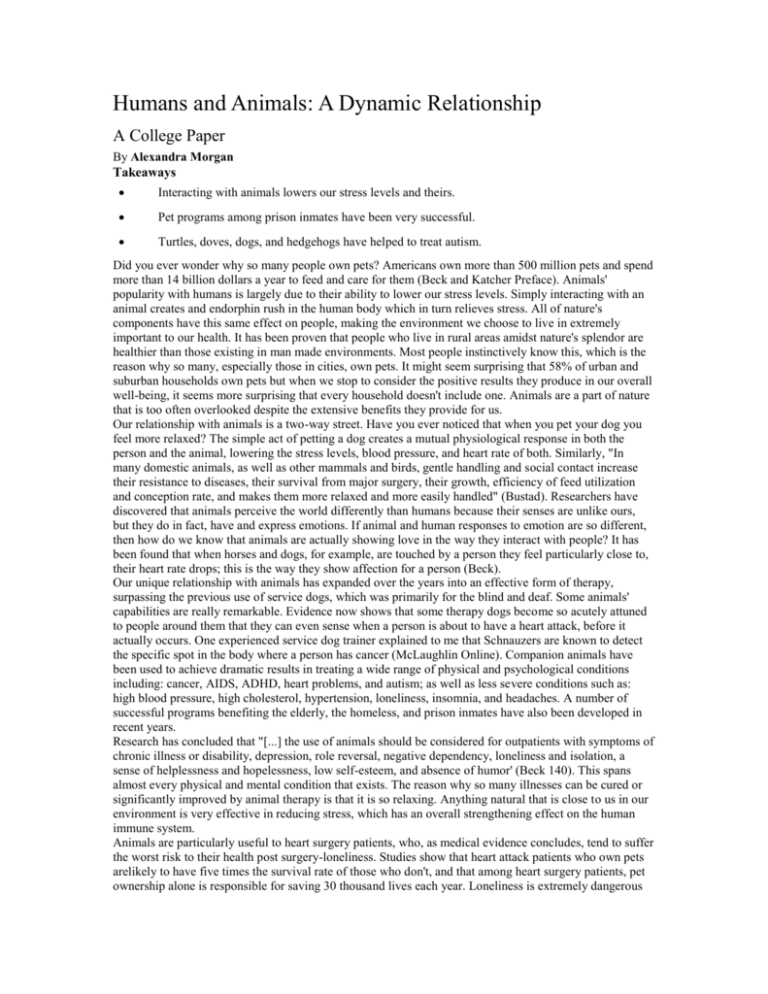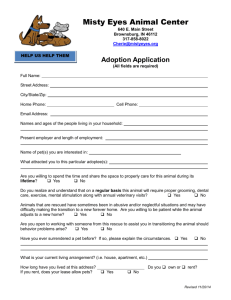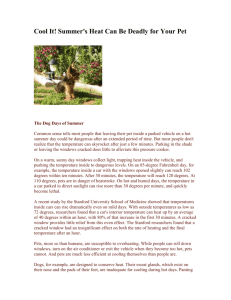Humans and Animals - college paper
advertisement

Humans and Animals: A Dynamic Relationship A College Paper By Alexandra Morgan Takeaways Interacting with animals lowers our stress levels and theirs. Pet programs among prison inmates have been very successful. Turtles, doves, dogs, and hedgehogs have helped to treat autism. Did you ever wonder why so many people own pets? Americans own more than 500 million pets and spend more than 14 billion dollars a year to feed and care for them (Beck and Katcher Preface). Animals' popularity with humans is largely due to their ability to lower our stress levels. Simply interacting with an animal creates and endorphin rush in the human body which in turn relieves stress. All of nature's components have this same effect on people, making the environment we choose to live in extremely important to our health. It has been proven that people who live in rural areas amidst nature's splendor are healthier than those existing in man made environments. Most people instinctively know this, which is the reason why so many, especially those in cities, own pets. It might seem surprising that 58% of urban and suburban households own pets but when we stop to consider the positive results they produce in our overall well-being, it seems more surprising that every household doesn't include one. Animals are a part of nature that is too often overlooked despite the extensive benefits they provide for us. Our relationship with animals is a two-way street. Have you ever noticed that when you pet your dog you feel more relaxed? The simple act of petting a dog creates a mutual physiological response in both the person and the animal, lowering the stress levels, blood pressure, and heart rate of both. Similarly, "In many domestic animals, as well as other mammals and birds, gentle handling and social contact increase their resistance to diseases, their survival from major surgery, their growth, efficiency of feed utilization and conception rate, and makes them more relaxed and more easily handled" (Bustad). Researchers have discovered that animals perceive the world differently than humans because their senses are unlike ours, but they do in fact, have and express emotions. If animal and human responses to emotion are so different, then how do we know that animals are actually showing love in the way they interact with people? It has been found that when horses and dogs, for example, are touched by a person they feel particularly close to, their heart rate drops; this is the way they show affection for a person (Beck). Our unique relationship with animals has expanded over the years into an effective form of therapy, surpassing the previous use of service dogs, which was primarily for the blind and deaf. Some animals' capabilities are really remarkable. Evidence now shows that some therapy dogs become so acutely attuned to people around them that they can even sense when a person is about to have a heart attack, before it actually occurs. One experienced service dog trainer explained to me that Schnauzers are known to detect the specific spot in the body where a person has cancer (McLaughlin Online). Companion animals have been used to achieve dramatic results in treating a wide range of physical and psychological conditions including: cancer, AIDS, ADHD, heart problems, and autism; as well as less severe conditions such as: high blood pressure, high cholesterol, hypertension, loneliness, insomnia, and headaches. A number of successful programs benefiting the elderly, the homeless, and prison inmates have also been developed in recent years. Research has concluded that "[...] the use of animals should be considered for outpatients with symptoms of chronic illness or disability, depression, role reversal, negative dependency, loneliness and isolation, a sense of helplessness and hopelessness, low self-esteem, and absence of humor' (Beck 140). This spans almost every physical and mental condition that exists. The reason why so many illnesses can be cured or significantly improved by animal therapy is that it is so relaxing. Anything natural that is close to us in our environment is very effective in reducing stress, which has an overall strengthening effect on the human immune system. Animals are particularly useful to heart surgery patients, who, as medical evidence concludes, tend to suffer the worst risk to their health post surgery-loneliness. Studies show that heart attack patients who own pets arelikely to have five times the survival rate of those who don't, and that among heart surgery patients, pet ownership alone is responsible for saving 30 thousand lives each year. Loneliness is extremely dangerous for cancer patients as well. Negative emotions and attitudes are known to be a relevant risk factor in the diagnosis and progression of cancer. Feelings of depression, hopelessness, and panic are common among these patients. Norman Cousins, author of Head First, documents a study conducted by Doctors H. Steven Greer and Keith W. Pettingale. Their study of women who had breast cancer surgery uncovered the fact that "Survival without recurrence of cancer was more common among patients who responded with 'fighting spirit' than among patients who expressed helplessness or hopelessness" (Cousins 216). It has been reported that pets provide cancer patients with a reason to live, a friend they can confide in, and hope. They also offer the families of terminally ill patients support, affection, and a "willing ear" (Howie Online). AIDS victims are often among those who are most in need of a companion animal. In confronting a disease that is as frightening and devastating as AIDS, many find themselves without a job, ostracized and isolated from friends, family, and society, and in need of any connection they can find. An estimated 40 percent of people with AIDS in the United States own pets (Delta Society Online). Many psychologists and psychiatrists now routinely include the use of pets in their practice, finding that they are helpful in treating all kinds of disorders. Animals increase social and verbal behavior and can serve as a mediator between therapist and patient when a connection cannot be made. In severe psychological cases such as autism, animals have made amazing communication breakthroughs where other kinds of treatment often fail. Several doctors now use dolphins to capture the attention of autistic children, but even turtles, doves, dogs, and hedgehogs have proven capable of reaching them. In one of the most documented cases, an autistic child named Bethsabee smiled for the first time on seeing a dove take flight before her eyes; months later she spoke her first words (Beck 136-139). Animals can not only attract the attention of people who are almost completely detached socially, such as the autistic, they can also re-orient those who are socially aggressive. Research has shown that animals can break some of the socially unacceptable behaviors of young children with attention deficit hyperactive disorder. Children with ADHD are "impulsive, have difficulty learning situational rules governing behavior, are highly distractible, and have limited social skills [...]." Many of them are also " [...] aggressive, noncompliant, socially disruptive, resistant to control, and often violate age-appropriate social norms and the rights of others" (Beck 143). One study done by Aaron Katcher and Gregory Wilkins of boys between the ages of nine and fifteen, most diagnosed with ADHD, tested the effectiveness of nature-based treatment programs as a supplement to their normal schooling. They incorporated a course similar to Outward Bound and a Companionable Zoo Program into their daily routine. When the children went to the zoo they were instructed to "be gentle with the animals, which included talking softly while in the zoo, and they had to respect the animals and each other and avoid speech that devalued each other or the animals." The rules of conduct the children had to follow when they were in the zoo indirectly and subtly instilled in them a sense of respect for themselves and life. The program required the kids to acquire a basic knowledge of skills such as the proper feeding, care, and maintenance of bedding for the animals. Their final requirement was to adopt and learn the biology of a particular pet. After the children had completed these assignments, they could then go on learning more, or stop there if they chose to do so. Many went above and beyond the basic skills they were required to learn, and enjoyed the program. Katcher and Wilkens' study concluded that in certain individual cases of ADHD, animals could improve "impulse control" and diminish aggressive and violent behavior (Beck 143-146). One of the greatest strengths of therapy animals is their ability to provide unlimited affection and warmth. A pet's love is very comforting to people who are undergoing stress because of major changes in their lives. Animals' capacity to help people adjust to change can be especially important to the elderly after admission to a nursing home. In this type of environment elderly people often experience depression, which can result in a rapid declin in physical and mental health. When animals are brought into these facilities they provide the elderly with a companion who doesn't care what age they are and doesn't react to how they may look. Often these animals can trigger forgotten memories from childhood and compensate for family members who don't visit often enough, reviving a will to live (Beck 129-131). Like the elderly, the homeless also turn to pets for support and motivation. It's surprising that under these circumstances anyone would want something extra to take care of, but reports show that the homeless can be some of the most attached pet owners. In a survey conducted by Robert and Aline Kidd, of the 105 homeless men and women interviewed many showed utter devotion to their pets with responses like, "He's the only thing that loves me" and "I always feed her first." One women stated, "She doesn't mind that I'm dirty or smell - she loves me anyway" (Ptak Online). Animals are consistently able to touch people that others would consider hopeless. The Prison Pet Partnership Program utilizes pets as a method of reform for inmates. This particular program offers inmates the opportunity to acquire vocational skills in pet-related services, such as boarding, training, and grooming dogs, increasing their chances of finding stable jobs in the outside world. In 1986 the program reported that "100% of the inmates who have been released have found employment" (Animal Friends Online). In another prison program, a handful of maximum security prisoners trained service dogs to alert their owners of an oncoming seizure (Bustad Online). Even though we've become somewhat desensitized to all kinds of living things around us, that doesn't mean the cycle can't be broken. Leo Bustad and other researchers studying the human-animal bond have suggested a number of ways we can revive our relationship with nature's living creatures. Prison programs have come a long way with the recent use of animal as a part of inmate reform, but improvements could still be made to expand the number of prisons implementing this form of therapy. Many more service dogs are needed than the number that are available, creating the necessity for a greater number of people to train them. A sum of money should be alloted from medical insurance or Social Security programs for people who want this type of treatment or assistance, because it's extremely expensive to provide and maintain. In order to extend the benefits of pets to everyone, it should be made more affordable. Free animal clinics should be provided where veterinary students can neuter, spay, and treat injured animals that would otherwise be denied medical attention. Humane societies don't have to euthanize all of the stray animals that aren't claimed. The San Francisco SPCA is one of the few places in the United States that keeps all of its animals until they've found a home (Koning Online). A similar program was adopted by state law in Oregon in the 1970's. If it can be done somewhere, it can be done everywhere. The most important place where a change could be made is in the school system, because animals promote a socialization process in young children that lasts a lifetime. Animals "provide a sense of constancy for foster children," and "develop nurturing behavior and humane attitudes in children who may grow to be more nurturing adults" (Bustad Online). School curicula should include a nature education program, teaching kids about trees, plants, and animals, allowing them to get out and play outdoors. An opportunity to participate in more varied and challenging activities such as hiking, camping, and boating should be provided, especially for children in cities. If horseback riding, for instance, for "children with a wide variety of physical disabilities, including cerebral palsy and spastic muscle disorders" can instill in them a normal perspective of competition, balance, and motivation to exercise, the same would be true of all children (Beck 149). The nature program should include information about the specific ways that animals affect our health and happiness. As an extension of this concept in schools, the dissection of animals in science courses should be made completely optional for everyone. Doctors have concluded that while animal therapy cannot take the place of traditional treatment, it certainly has been effective. It's an innovative approach to disease prevention and offers a major contribution to the overall well-being of a majority of people. There is a scientific reason underlying the basis of these successful therapies that we should make a conscious effort to become more aware of and understand. A strong connection to nature is simply physically and psychologicly vital to all of us. That's the primary reason for protecting nature in all of its forms, relevant to all people everywhere. When we're children we learn the value of a human life and the animals that share the world with us, and these fundamentals stay with us forever. We can provide opportunities for those who haven't learned that yet to be taught, and for those who are distressed with illness or bad circumstances, the opportunity to remember it. Works Cited Animal Friends. "Prison Programs." Animal Friends Website. 2 Oct. 2000. Beck, Alan and Aaron Katcher. Between Pets and People: The Importance of Animal Companionship. West Fayette, Indiana: Purdue University Press, 1996. Beck, Alan. "Ask the Expert." Discovery Channel Website. 6 Nov. 2000. Bustad, Leo. "Recent Discoveries About Our Relationships With The Natural World," chapter from Compassion: Our Last Great Hope, Selected Speeches of Leo Bustad, DVM, Ph.D. Renton, Washington: The Delta Society, 1996. The Delta Society Website. 6 Nov. 2000. Cousins, Norman. Head First: The Biology of Hope and the Healing Power of the Human Spirit.New York, New York: Penguin Books, 1989. Howie, Ann R., ACSW. "The Presence of Pets in Young Families Experiencing Cancer." The Delta Society Website. Koning, Patricia. "RX: Dogs, Cats, Guinea Pigs, Rabbits...." Women's Wire Website. 28 Oct. 2000. McLaughlin, Christine R. "The Positive Power of Pets." Discovery Channel Website.6 Nov. 2000. Ptak, Andrea Leigh. "Studies of Loneliness: Recent Research into the Effects of Companion Animals on Lonely More resources http://deltasociety.org/ http://bestfriends.org/ http://2ndchance4pets.org/






